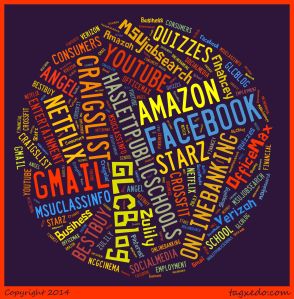This week, we were challenged to examine our infodiet and to pay attention to the source of the information that we experience on a regular basis. In his TED video, Ed Pariser (2011) states, “There’s this kind of shift in how information is flowing online… and if we don’t pay attention to it, it could be a real problem.” He calls this shift a “filter bubble” in which the information that we see is tailored to fit our interests based upon what we have clicked on in the past. As a result, we become inadvertently indulged with an infodiet of our own preferences.
I decided that, in order to get a good look at my infodiet, I would conduct a history search. I found that last month, I spend quite a bit of time on Facebook, chatting with friends or joining in on some of the affinity spaces there. Other sites that I frequent revolve around my business (blogging or education), graduate work, job sites, online shopping, and other sources of entertainment such as Netflix. Below is a word bubble that represents my infodiet:

Affinity spaces in which I currently interact in varying degrees include spaces for business, parenting, teaching, DIY projects, books and T.V. series’, meal preparation, and spiritual practice. I use Facebook, blogging, Pinterest, and YouTube, among other portals to engage in these spaces, but after examination, I realize how limited my infodiet is online. Even searching through Google can be narrow and limiting; I sometimes feel like a robot on the internet, frequenting the same places over and over again. As a result, I decided to search out new places that will hopefully help me get started with transforming my infodiet in the future.
I first decided to focus my attention on material that could be useful in combining my two MATC concentrations: Educational Technology and Literacy. Two sites I found were https://www.fanfiction.net and http://www.reading-rewards.com/. The first one is an affinity space that allows users to expand on popular literature. I thought about how fanfiction could be created by elementary students in places like Edmodo or a teacher’s blog. Students could safely share alternative endings to stories or other creative writing. Although I don’t have much experience with fanfiction, I think that the idea is creative and has the potential to strengthen reading and writing skills. The other website, Reading Rewards, is a fun way for students to track reading instead of using a traditional reading log. It provides rewards for completing books, and it allows students to write reviews and check out new books.
Finally, I turned my attention to internet searches. Normally, I search through Google, regardless of what I’m looking for. However, when teaching students about internet safety, or even just to search for more specific sites that might appeal to students, I turned to kid-friendly search engines. This site, http://www.kidfriendlysearch.com/Kid_Friendly.htm, links users to a number of different search engines that are useful for students who want to search for a topic, both for fun and for research. Particularly, I enjoyed browsing on the kid-version of Google, http://www.kidrex.org/.
All of the new places that I’ve explored online will help me to further develop my infodiet. Interestingly, all sites that I searched are places that I’ve heard of before. However, it took taking a good look at them to realize the value that these places hold. I plan to explore further the connection between literacy and technology, as well as pursue the importance of using various search engines depending upon who is browsing and the content that is being browsed.
References:
Tagxedo – Word Cloud with Styles. (n.d.). Retrieved September 14, 2014.
Gee, J. (2013). The anti-education era: Creating smarter students through digital learning.
Pariser, E. (2013). Beware online filter bubbles.
Fanfiction – (n.d.). Retrieved September 22, 2014.
Reading Rewards – (n.d.). Retrieved September 22, 2014.
Kid Friendly Search – (n.d.). Retrieved September 22, 2014
Kidrex – (n.d.). Retrieved September 22, 2014
